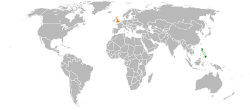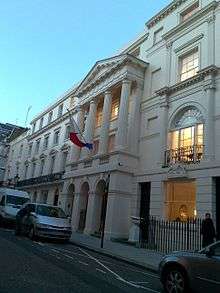Philippines–United Kingdom relations
 |
|
Philippines |
United Kingdom |
|---|---|
Philippines – United Kingdom relations refers to the bilateral relations between the Republic of the Philippines and the United Kingdom of Great Britain and Northern Ireland. Formal diplomatic relations were established between the two countries on July 4, 1946. Relations between the two countries are cordial.[1]
Philippine Pre-Independence
Relations between the Philippines and the United Kingdom date to Sir Francis Drake's arrival in Mindanao in 1579 after an almost three year circumnavigational voyage aboard Golden Hind. Economic ties defined relations for the next four centuries. The Philippines became a part of the footprint of the East India Company. British companies took part in improving transportation infrastructure in the Philippines.[1]
British occupation of Manila
The Kingdom of Great Britain occupied the city of Manila and nearby port of Cavite between 1762 and 1764. Strong resistance from the provisional Spanish colonial government established by members of the Royal Audience of Manila and their Filipino allies prevented British forces from taking control of territory beyond the neighbouring towns of Manila and Cavite. The occupation was ended as part of the peace settlement of the Seven Years' War.
Modern era

The British Parliament's Foreign Affairs Committee visited the Philippines in 1986 to express support for the new government of then President Corazon Aquino. British Foreign Secretary Sir Geoffrey Howe visited in 1988 in an attempt to further strengthen bilateral relations. The following year, Filipino Foreign Secretary Raul Manglapus became the first Philippine minister to visit Britain.[1]
Two members of the British Royal Family are known to have visited the Philippines. In 1999, Anne, Princess Royal visited the Philippines to visit the British School Manila in Parañaque. In 2001, Prince Andrew, Duke of York visited the Philippines to attend the inauguration of the British School Manila, upon its relocation from Parañaque to Bonifacio Global City, Taguig. Prince Andrew, Duke of York revisited the British School Manila in 2004.[2]
Economic relations
The United Kingdom is currently the largest European investor in the Philippines. Likewise, most European tourists who visit the Philippines come from the United Kingdom, with about 90,000 visitors yearly.[1][3]
The UK government spends in the region of £2 million per year of funding to facilitate scientific collaboration with the Philippines. The fund, administered through the British Embassy Manila, is to foster science and innovation partnerships for joint research on development topics, researcher training and fellowships, and innovation capacity building programmes. These joint projects tackle priority development concerns such as environmental resilience, food and energy security, and health.[4]
British Ambassador Asif Ahmad said: "Science and technology are key drivers to economic development. The Newton Fund will engage British and Filipino scientists as partners to increase their research and innovation capacity. The application of knowledge, tailored to the needs of the people of the Philippines, will address their current priorities and address long-term sustainable growth. The British invention of the internet transformed lives and it is not beyond reason to hope that Filipino-UK ingenuity could unlock further discovery."[4]
Military relations
The Philippines sided with the Allies in the Second World War together with Great Britain. The United Kingdom plays an important part in the Mindanao peace process.
Immigration
There were only a small population of Filipinos in the United Kingdom until the late 20th century. The numbers increased from around 18,000 in 1986 to about 250,000 in 2010. They work in a variety of sectors, such as information technology, engineering, aviation, education, hospitality and healthcare.[5]
Most notably, the UK has been relying on the professional expertise of thousands of Filipino workers to fill critical gaps in the delivery of health services, exemplified by the influx of Filipino nurses that have made them an essential part of the UK National Health Service.[5]
There are also a significant number of Filipino scholars, many leaders in their respective fields, who have been selected for postgraduate programs in British universities.[5]
About 10,000 Britons reside in the Philippines, mostly expatriates, spouses and retirees.[3]
Disaster reliefs
Typhoon Haiyan, known as Yolanda in the Philippines, was one of the deadliest natural disasters in the country's history, and was one of the most powerful typhoons ever recorded.
The UK provided £77m of humanitarian aid, making it the largest single donor. In addition to the UK government's response, the British public donated a further £85m through the Disasters Emergency Committee (DEC) appeal.[6]
References
- 1 2 3 4 "Bilateral relations". London Philippine Embassy. Retrieved June 25, 2012.
- ↑ "History". British School Manila. Retrieved 22 November 2014.
- 1 2 "Philippines and UK's growing relationship | Manila Bulletin". Mb.com.ph. 2011-05-24. Retrieved 2012-06-02.
- 1 2 https://www.gov.uk/government/world-location-news/science-and-innovation-fund-launched-in-the-philippines
- 1 2 3 http://philembassy-uk.org/bilateral-relations
- ↑ http://www.theguardian.com/global-development/2014/mar/11/typhoon-haiyan-philippines-uk-response-dfid-icai

